
An epiphyte is a plant or plant-like organism that grows on the surface of another plant and derives its moisture and nutrients from the air, rain, water or from debris accumulating around it. The plants on which epiphytes grow are called phorophytes. Epiphytes take part in nutrient cycles and add to both the diversity and biomass of the ecosystem in which they occur, like any other organism. In some cases, a rainforest tree's epiphytes may total "several tonnes". They are an important source of food for many species. Typically, the older parts of a plant will have more epiphytes growing on them. Epiphytes differ from parasites in that they grow on other plants for physical support and do not necessarily affect the host negatively. An organism that grows on another organism that is not a plant may be called an epibiont. Epiphytes are usually found in the temperate zone or in the tropics. Epiphyte species make good houseplants due to their minimal water and soil requirements. Epiphytes provide a rich and diverse habitat for other organisms including animals, fungi, bacteria, and myxomycetes.

In the botanical classification of plants, Aeridinae Pfitzer is a subtribe of the tribe Vandeae whose representatives all have a monopodial growth habit and do not possess pseudobulbs.

Laelia is a small genus of 25 species in the orchid family (Orchidaceae). Laelia species are found in areas of subtropical or temperate climate in Central and South America, but mostly in Mexico. Laelia is abbreviated L. in the horticultural trade.
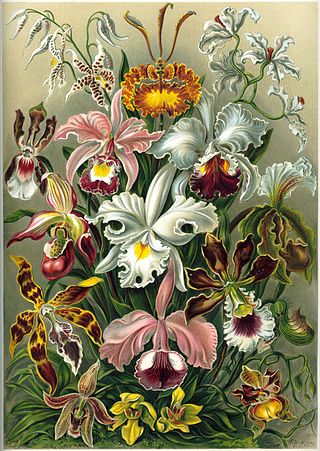
The taxonomy of the Orchidaceae (orchid family) has evolved slowly during the last 250 years, starting with Carl Linnaeus who in 1753 recognized eight genera. De Jussieu recognized the Orchidaceae as a separate family in his Genera Plantarum in 1789. Olof Swartz recognized 25 genera in 1800. Louis Claude Richard provided us in 1817 with the descriptive terminology of the orchids. (See External links below). The next step was taken in 1830-1840 by John Lindley, who recognized four subfamilies. He is generally recognized as the father of orchid taxonomy. The next important step was taken by George Bentham with a new classification, recognizing subtribes for the first time. This classification was first presented in a paper that Bentham read to the Royal Society in 1881. Then it was published in 1883 in the final volume of Genera Plantarum. The next great contributors were Pfitzer (1887), Schlechter (1926), Mansfeld (1937), Dressler and Dodson (1960), Garay (1960, 1972), Vermeulen (1966), again Dressler (1981). and Burns-Balogh and Funk (1986). Dressler's 1993 book had considerable influence on later work.

The Orchidoideae, or the orchidoid orchids, are a subfamily of the orchid family (Orchidaceae) that contains around 3630 species. Species typically have a single (monandrous), fertile anther which is erect and basitonic.
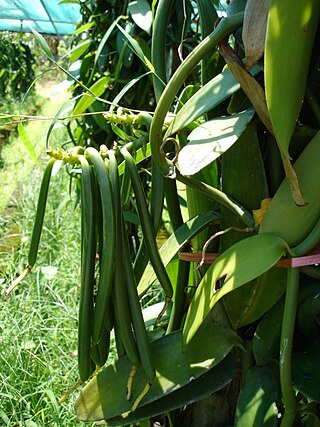
Vanilloideae is one of the subfamilies of orchids belonging to the large family Orchidaceae.

Xerorchis is an orchid genus in the subfamily Epidendroideae. It is the sole representative of the tribe Xerorchideae. Xerorchis is only found in South America.
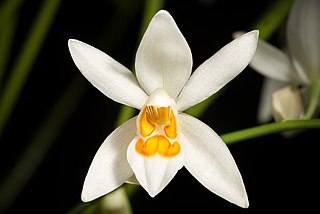
Arethuseae is a mid-sized tribe of orchids in the subfamily Epidendroideae. This tribe was initially categorized by John Lindley in 1840. Its largest subtribes are Arethusinae and Coelogyninae.
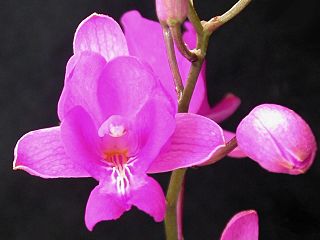
Bletiinae is a small-sized subtribe of orchids in the tribe Epidendreae of the subfamily Epidendroideae.
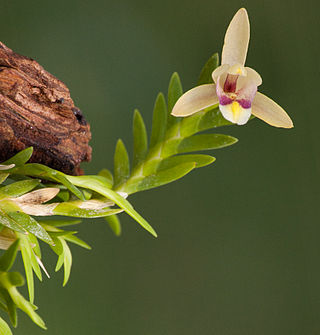
The Vandeae is a large monophyletic tribe within the family of orchids.

Cattleya walkeriana, or Walker's cattleya, is a species of orchid. It differs from most species of Cattleya by having inflorescences which arise from the rhizome instead of from the apex of the pseudobulb. In its native habitat it grows as either an epiphyte or a lithophyte, sometimes in full sun, at elevations up to 2000 meters. Pseudobulbs are relatively short, bulbous or fusiform, with one or two ovate leaves at the apex. Inflorescence is one- or few-flowered, about 8" (20 cm) tall. Flowers are 4-5" (9-12 cm) across.

The tribe Epidendreae of the Orchidaceae, within the subfamily Epidendroideae. It includes six subtribes, approximately 120 genera, and over 6,000 species. Popular among orchid collectors, it features well-known genera such as Laelia, Cattleya, and Encyclia, as well as smaller species like Dracula, Dryadella, Masdevallia, and Restrepia.

Dimorphorchis is a genus of flowering plants from the orchid family, Orchidaceae. It contains 9 species, which are native to Papua New Guinea, the Philippines, Indonesia, Malaysia, Solomon Islands, and Brunei. It is remarkable for its two flower morphs present on the same plant.

Microsaccus is a genus of flowering plants from the orchid family, Orchidaceae. It is native to Southeast Asia.

Polystachyinae is a subtribe within the tribe Vandeae in family Orchidaceae. It consists of 2 genera and about 228 known species. The type genus of this subtribe is Polystachya. The group is pantropical, being native to tropical Africa primarily, but also to tropical America. Members of this group are epiphytic and are distinguished from the other subtribes in the tribe Vandeae by their sympodial growth habit and the presence of four pollinia. Pollination is mostly by small species of bees, however some species exhibit auto-pollination.

The Eriinae form a subtribe of Podochileae, a tribe of the orchid family (Orchidaceae). The name is derived from the genus Eria.

Dendrobieae is a tribe in the subfamily Epidendroideae, in the family Orchidaceae. The Dendrobieae are mostly tropical, epiphytic orchids which contain pseudobulbs.

Calypsoinae is an orchid subtribe in the tribe Epidendreae of subfamily Epidendroideae. It has previously been recognized as tribe Calypsoeae in the subfamily Epidendroideae.

Neottieae is an orchid tribe in the subfamily Epidendroideae. It contains six genera and over 200 species distributed mainly in temperate and subtropical zones of the northern hemisphere. All its members are terrestrial plants, hinting at an early branching with Epidendroideae which is largely an epiphytic group. Neottieae is likely to be the result of a single temperate radiation of epidendroids, although it appears that some lineages in this tribe have crept back into the tropics.

Trachoma, commonly known as spectral orchids, is a genus of flowering plants in the family Orchidaceae. Orchids in this genus are epiphytic plants with leafy stems, crowded, leathery leaves arranged in two ranks and a large number of relatively small, short-lived flowers that often open in successive clusters. The sepals and petals are free from and more or less similar to each other, except that the petals are often smaller. The labellum is rigidly fixed to the column and is more or less sac-shaped. There are about 17 species distributed from Assam to the Western Pacific Ocean. Most species grow in rainforests, often on emergent trees such as hoop pine.



















